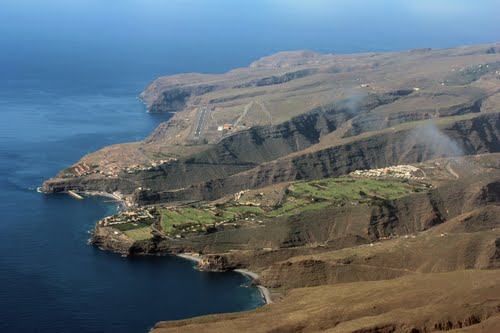La Gomera is shaped like a flattened dome, the top of which is covered with a lush laurel and cedar forest. The highest point is Alto de Garajonay (1487 m n.p.m.). The island is torn by deep gorges, descending towards the coast. The ravines end with small volcanic beaches - the rest of the coast consists of steep cliffs. The almost circular La Gomera is divided into five municipalities: Saint Sebastian, hermigua, Beautiful valley, Agulo in Alajero.
Climate
You could say, that the average annual temperature in La Gomera is approx. 25°C (20° C in winter and up to 30 ° C in summer), however, this principle works mainly on the coast. You have to remember, that as altitude changes, the aura changes significantly, therefore even if it is warm and sunny by the sea, in the center of the island, at a height of over 1000 m n.p.m., it could be much cooler, and on top of that it is humid and windy. This should be especially remembered by people planning trips to Garajonay National Park. It rarely rains in La Gomera, and if anything, it's usually around November. After exceeding a certain height, a phenomenon called horizontal rain can be observed (condensing very dense fog), therefore going to the mountains, it is worth taking something rainy. You can clearly see the difference between the green, a little cooler in the north and warm, sun-scorched noon.
Arrival
Plane
A small airport (922873000) is situated approx. 3 km west of Playa de Santiago i 35 km from San Sebastian. It operates the flights of the island line Bintercanarias (w922873024, fax 922873025, info@bintercanarias.es, www.binternet.com), which offers direct connections to Tenerife Norte Airport (codz. 4 flights), from where planes depart for the remaining islands. From the airport to Playa Santiago, San Sebastian i Valle ; Gran Rey can be reached by bus, however, they do not run very often, therefore, a much more convenient and faster option is to rent a car at the airport or ; taxis (do Playa Santiago ok. 8 €, do San Sebastian i Valle Gran Rey ok. 35 €).
Prom
The easiest way to get to La Gomera is by ferry. Connections to the port of Tenerife Los Cristianos are served by two companies: Fred Olsen (®922871007, www.fredolsen.es; pn.-pt. 4 times a day, sb. i nd. 2 times a day; ok. 60 € return, with a car approx. 160 €) Oraz Shipping Company Arms (922871324, www.navieraarmas.com; pn.-pt. 4 times a day; ok. 50 € return, j with a car approx. 90 €). Both companies ; they grant a discount of approx. 10% people, who will buy a return ticket. Moreover, the Naviera Armas ferry can take you from San Sebastian to La Palma (once a day; ok. 70 € return, with a car approx. 170 €), a catamaran by Fred Olsen at El Hierro (once a day; ok. 100 € return, with the car 250 i). According to an ad by Fred Olsen, the cruise of Los Cristianos — La Gomera takes approx 35 min, however, you have to remember, that we are talking about the crossing itself – after taking into account the time needed to take off from the shore and mooring, it turns out, that you spend about an hour on the ferry. Slower Navier Armas units (90 min from take-off to mooring) it is worth choosing for several reasons: firstly, on the company's ferries, you can go out onto the open deck during the crossing – views of La Gomera, and above all, Tenerife and the Teide volcano towering over the ocean, which in good weather can be seen in all its glory, they are truly unforgettable; secondly, Navier Armas ferries are larger and therefore less undulating is felt on them; Thirdly – they are cheaper.

Great collection of information. I will definitely use it 🙂